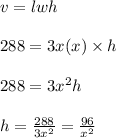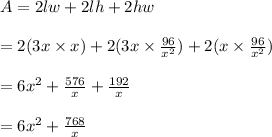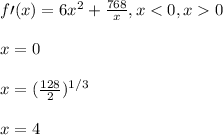Answer:
a.

b. 288 sq units
Explanation:
Given the dimensions of the base sides and the cuboids volume, we can calculate its height:

Having determined h=
 .
.
The surface area of the cuboid is the sum of all its faces area;

 =A, hence, proved!
=A, hence, proved!
b. Find stationary value of A
We find the critical point of the function:

Hence, x is undefined. The stationary area is therefore calculated as:

The area is 288 sq units